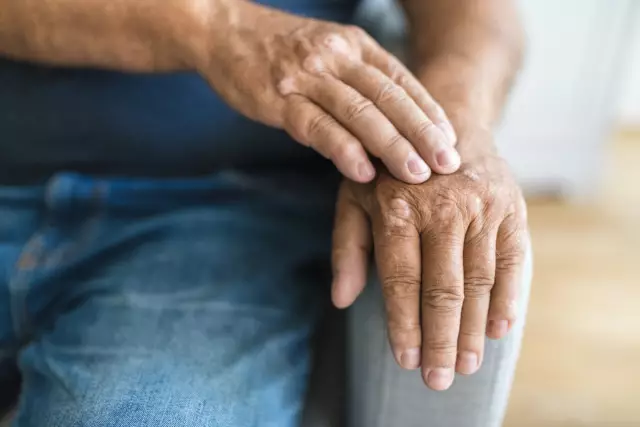- Author Rachel Wainwright [email protected].
- Public 2023-12-15 07:39.
- Last modified 2025-11-02 20:14.
What to do if legs swell during pregnancy: advice, folk remedies
The content of the article:
- The reasons
- Symptoms
- Diagnostics
- Treatment
- How to remove swelling on the legs during pregnancy with folk remedies
- Forecast
- Prevention
- Video
Swelling of the legs during pregnancy: what to do if the legs swell and why it happens
According to medical statistics, every 8 out of 10 pregnant women experience leg swelling. This condition may be due to various factors and therefore it is impossible to unequivocally answer the question of what to do if the legs swell during pregnancy - the answer will depend on what caused this condition.

In most cases, leg edema in pregnant women is associated with physiological causes.
The reasons
The causes of edema in pregnant women are divided into physiological and pathological.
Physiological reasons are associated with complex changes occurring in a woman's body during gestation:
- An increase in the volume of circulating blood. Starting in the second trimester, plasma volume increases by 20%. This, to a certain extent, contributes to the accumulation of extracellular fluid, as a result of which the legs begin to swell.
- Hormonal changes. During pregnancy, the hormonal background undergoes significant changes, which leads to an increase in the permeability of the vascular walls and the sweating of plasma into the intercellular space of soft tissues.
- Compression of veins by an enlarged uterus. As the pregnancy progresses and the fetus grows, the body of the uterus rapidly and significantly increases in volume. At the same time, it begins to squeeze the veins and lymphatic vessels. Violation of blood circulation leads to the appearance of edema of the lower extremities.
- The increase in body weight. From 16-20 weeks of pregnancy, a woman's weight begins to increase rapidly. In addition, the center of gravity of the body shifts. All this increases the load on the legs and provokes the appearance of puffiness.
The appearance of edema in the second half of gestation may be the first symptom of late toxicosis - OPG-gestosis. The development of this dangerous pathological condition is caused by the disruption of the adaptive mechanisms of the body of a pregnant woman, which is characterized by:
- spasm of capillaries;
- hemodynamic disorders;
- an increase in the permeability of the vascular walls;
- a decrease in the volume of circulating blood;
- disorders of blood supply to the placenta, kidneys, brain;
- increasing hypoxia of internal organs of both the expectant mother and her child;
- disorders of protein and water-electrolyte metabolism.
The exact mechanism for the development of OPG-gestosis is currently unknown. Factors predisposing to its occurrence are:
- kidney disease (pyelonephritis, glomerulonephritis);
- congenital and acquired heart defects;
- arterial hypertension;
- endocrine pathologies (diabetes mellitus, obesity);
- rhesus conflict;
- intrauterine growth retardation;
- the mother's age is under 18 or over 35;
- bad habits (smoking, alcohol abuse).
Symptoms
If edema occurs under the influence of physiological reasons, then they are characterized by the following symptoms:
- They are expressed slightly and usually affect only the area of the foot, ankle, mid-calf.
- They arise by the end of the day and, after resting in a horizontal position, disappear on their own.
- They can be accompanied by the appearance of a feeling of heaviness in the legs, night cramps, after which the calf muscles can hurt for several hours.
In cases where the legs swell greatly during pregnancy, the cause is most likely OPG-gestosis. In its course, several stages are distinguished:
| Stage of OPG-gestosis | Clinical manifestations |
| Dropsy |
Initially, the pathology proceeds secretly, it can be suspected by a pathological increase in body weight. Women often note that worn-out shoes suddenly become cramped for them. General health worsens. Then there is visible swelling of the feet and legs. If treatment is not started, then the edema spreads to the thighs and the anterior abdominal wall, arms. In severe cases, anasarca develops - swelling of almost all of the skin and the accumulation of fluid in the anatomical cavities of the body. With dropsy, there is no arterial hypertension and proteinuria. |
| Nephropathy | Edema is combined with progressive arterial hypertension. After 3-6 weeks, proteinuria joins these symptoms - the presence of protein in the urine. Other signs: sleep disturbances, dizziness, pain in the lumbar region, dyspepsia, thirst. Hepatomegaly, pain in the right upper quadrant of the abdomen, and jaundice are characteristic of liver damage. |
| Preeclampsia | Symptoms of damage to the central nervous system and increased intracranial pressure (headache, nausea, vomiting) are added to the signs of nephropathy listed above. Especially often with preeclampsia, visual impairment is noted. |
| Eclampsia | A pregnant woman has a sudden loss of consciousness and develops a seizure, after which she falls into a coma. |
Diagnostics
Only a doctor can answer the question of why the legs swell during pregnancy in each case after the necessary examination. It may include:
- general analysis of urine and blood;
- blood chemistry;
- coagulogram;
- Ultrasound of the uterus, kidneys, liver;
- Doppler ultrasonography of the vessels of the lower extremities, uteroplacental blood flow;
- ECG, Echo-KG.
If indicated, the woman consults with other narrow specialists (nephrologist, vascular surgeon).
Treatment
Since swelling of the lower extremities during pregnancy can cause various causes, therapy should be aimed at eliminating them.
You should not get rid of physiological edema by limiting the intake of fluids and salt. However, the consumption of pickles, marinades, smoked meats and overly salty foods should be avoided. Also, women are recommended:
- take short walks in the fresh air several times a day;
- to improve the outflow of blood and lymph 3-4 times a day, take a reclining position with straightened and raised legs for 15-20 minutes;
- do relaxing warm (not hot!) foot baths with sea salt at night;
- perform a light foot massage.
With varicose veins of the lower extremities, the patient is shown the systematic wearing of compression hosiery, as well as the local use of ointments and gels with anticoagulants (Heparin ointment, Lioton gel). Foot massage in this case is contraindicated, as it can cause a thrombus to separate with the development of pulmonary embolism.
Treatment of gestosis is carried out in a hospital setting. In case of dropsy and nephropathy, the pregnant woman is hospitalized in the department of pathology of pregnancy, and in case of preeclampsia and eclampsia, in the intensive care unit.
Therapeutic measures are aimed at normalizing:
- water and electrolyte balance;
- blood pressure;
- permeability of the vascular walls;
- metabolic processes;
- blood rheology;
- hemostasis;
- functions of the central nervous system.
Indications for emergency delivery (emergency delivery):
- Moderate nephropathy, resistant to therapy for 7-10 days.
- Ineffectiveness of intensive therapy of preeclampsia carried out for 2-3 hours.
- Eclampsia (the operation is performed after the patient's condition has stabilized).
How to remove swelling on the legs during pregnancy with folk remedies
Folk remedies for the treatment of edema of the lower extremities can be used only if this phenomenon is associated with physiological reasons. Warm (not hot!) Foot baths with a solution of sea salt or decoctions of medicinal plants have a good effect:
- chamomile;
- sage;
- Oak bark.

With physiological edema, baths with medicinal plants can help
The normal psychoemotional state of a pregnant woman and normal sleep also contribute to a decrease in puffiness. Therefore, the doctor may recommend decoctions of medicinal preparations, which include herbs with a pronounced sedative effect:
- valerian;
- motherwort;
- hawthorn.
It is not recommended to use herbs with a diuretic effect during pregnancy, since their effect does not appear immediately and their treatment can cause a serious violation of the water-salt balance in the body of the expectant mother.
Forecast
The prognosis is determined by the underlying cause of the development of lower extremity edema in pregnant women. It is beneficial for varicose veins and physiological edema. With gestosis, especially its severe forms, the prognosis is always serious, since this pathology is always associated with the risk of severe complications:
- fetal death;
- death of a pregnant woman;
- pulmonary edema;
- swelling of the brain;
- acute renal failure;
- acute heart failure;
- hemorrhages in the brain and internal organs (kidneys, pancreas, intestines, adrenal glands, intestines);
- placental abruption;
- placental insufficiency;
- retinal disinsertion;
- development of HELLP syndrome.
The most severe course of gestosis is observed when it occurs early (with gestational age less than 28 weeks).
Prevention
Prevention of leg edema during pregnancy includes:
- observance of the regime of work and rest;
- a full night's sleep lasting at least 8-9 hours;
- maintaining an active lifestyle (walking, gymnastics, swimming, yoga), provided there are no contraindications;
- balanced healthy diet;
- timely detection and active treatment of any gynecological and extragenital diseases.
Video
We offer for viewing a video on the topic of the article.

Elena Minkina Doctor anesthesiologist-resuscitator About the author
Education: graduated from the Tashkent State Medical Institute, specializing in general medicine in 1991. Repeatedly passed refresher courses.
Work experience: anesthesiologist-resuscitator of the city maternity complex, resuscitator of the hemodialysis department.
Found a mistake in the text? Select it and press Ctrl + Enter.






